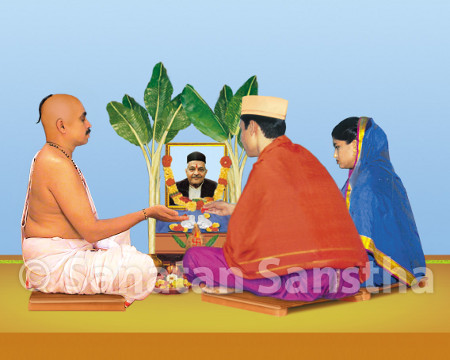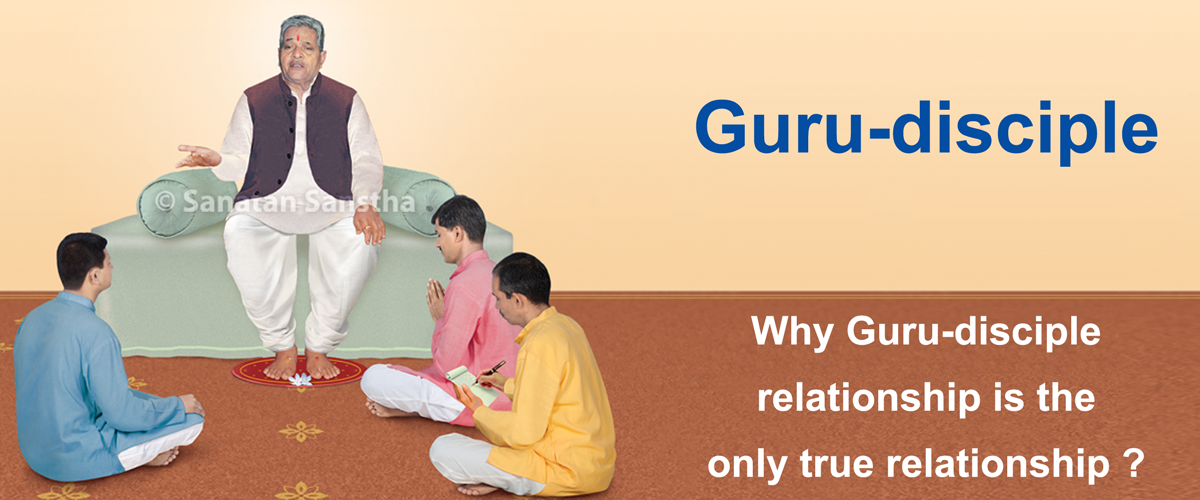Gurukrupa hi kevalam, shishya param-mangalam ।
Guru Purnima (Poornima), the most important day in the life of a disciple, is a celebration of the Guru and the Guru tattva (Principle). It is the day to offer our gratitude to the Guru who shows the way to Moksha (emancipation) but also holds our hand and leads us to it. The Adi Guru Sage Vyas, founder of the Guru-disciple lineage, is worshipped on this day. Hence, it is also known as Vyas Purnima. This year, Guru Purnima will be celebrated on Monday, 3rd July 2023.
The Guru is a physical manifestation of God. Hindu culture has placed the Guru on a higher pedestal than God; because the Guru teaches the seeker spiritual practice for God-realisation, gets it done from him, and helps him realise God. The Guru variously guides and consciously bestows His grace on the disciples continuously through lifetimes. It is impossible to repay the debt of a Guru, but we can humbly offer gratitude to the Guru! And Guru Purnima is the day to do that.
If you would like to physically participate in a Guru Purnima celebration, scroll down for a list of all the places where Sanatan Sanstha is hosting Guru Purnima celebrations.
God has given man everything, except contentment (Bliss or Shanti). That, the Guru bestows…
– Saint Bhaktaraj Maharaj

Watch Live!
The importance of Guru Purnima

The Guru-Shishya parampara (Guru and disciple lineage system) is a sacrosanct part of Hindu Dharma and the culture of India. Celebrating Guru Purnima is a way to offer obeisance to the Guru while also pledging to continue this rich spiritual heritage.

On Guru Purnima, the Guru tattva is a thousand times more active compared to other days. Hence the seva (physical service) and tyaag (donations to a worthy spiritual cause) will be a thousand times fruitful too. Guru Purnima accords the disciples a unique opportunity to serve the Guru tattva and reap the Guru’s grace.
Blessings of Saints
Blessings of Saints
Gurudakshina– offering your mind, body, and wealth
Guru Purnima is the day to offer your mind, body, and wealth unto the Guru. This simple sacrifice is the key to winning the Guru’s grace.
Gurupuja (ritualistic worship of the Guru)
After daily ablutions, the worshipper utters ‘guruparamparāsiddhyarthaṃ vyāsapūjāṃ kariṣye ।’ and commences the worship of the Guru. A freshly washed cloth is laid down, and lines are drawn with sandalwood in the north-south and east-west directions (12 lines each). It is the seat of Maharshi Vyas (Vyaspeeth). Brahma, Paratparshakti, Vyas, Shukadev, Gaudapad, Govindswami and Shankaracharya are invoked and invited to the Vyaspeeth. They are all offered the shodhashopachar puja (ritualistic worship involving 16 items). It is customary to worship one’s DeekshaGuru (Guru who initiated one into spiritual practice) and parents.
Guru puja
The Guru (or Sage Vyas) is worshipped on Guru Purnima. You can ritualistically worship the Guru at home with this easy to follow guide.

Guru puja
The Guru (or Sage Vyas) is worshipped on Guru Purnima. You can ritualistically worship the Guru at home with this easy to follow guide.
The Guru-Shishya Heritage
If there is a single term that can describe India, it is the Guru-Shishya parampara (lineage). Refuge with the Guru is the only route to emancipation. The Guru destroys the darkness of ignorance in the disciple’s life and unites him with the eternal light of the Parabrahman. Saints and learned people have extolled the virtues of the Guru over centuries. Satisfy your curiosity about the Guru, the Guru-Shishya lineage, Gurumantra, the Guru’s mission, etc., with these articles.
The Guru parampara of Sanatan Sanstha
Sanatan Sanstha is blessed with a Guru parampara of Spiritual masters who travelled far and wide to awaken the masses steeped in material woes and guide them towards Moksha. We offer obeisance to this illustrious lineage and pray for strength and blessings to continue their mission of spreading spirituality!
Do this to increase Bhav unto the Guru

Sachchidananda Parabrahman Dr Athavale initiated the Gurukrupayog (path of Guru’s grace) with blessings from His Guru, Saint Bhaktaraj Maharaj. Thousands of seekers have experienced that Gurukrupayog is the fastest path to spiritual progress and ultimately moksha. Now you too can experience it!
Join Sanatan’s free online Satsangs!
Celebrating Guru Purnima during adverse times
On the day of Gurupournima, most people visit their Guru and express their gratitude unto him. According to everyone’s faith, some visit Shri Guru, parents, Vidyaguru (Teachers who gave us knowledge), Acharyaguru (the priests who visit us for performing traditional worship) and some the Moksha Guru (those who have shown us the path of Moksha by guiding us in our spiritual practice) and express their gratitude unto Them. In case of adverse times, when this is not possible, even if you stay at home and worship the image of Shri Guru with devotion or perform Manaspuja with devotion, you will be bestowed with the blessings of the Guru Principle a thousand times over. Even if the Deity, Saint or Guru appear differently, the Guru Principle remains the same.
All devotees of a sect should perform worship in their respective homes at the same time as far as possible by finalising the time of worship in advance. ‘Performing worship at the same time gives more benefit of the power of unity’. Therefore, a time for performing worship should be fixed in advance unanimously.
A. The morning is considered as the auspicious time for worship. Those who are able to worship in the morning should do so in the morning.
B. If for some unavoidable reasons, it is not possible to worship in the morning, worship should be completed before sunset (before 7 p.m.).
C. Those who cannot perform worship at the appointed time, they should perform worship at a convenient time but before sunset.
D. Each one should worship the image, Idol or Paduka (Holy footwear) of Shri Guru or Deity of worship at home according to their respective beliefs.
E. Flowers should be offered after applying sandalwood paste to the pictures, Idols or Paduka. Panchopachar Pooja (Ritualistic worship involving five steps) should be performed by offering incense, lamps and naivedya. Finally, Aarti of Shri Guru should be performed.
F. Those who are not able to perform actual worship due to lack of material should perform mental worship (manaspuja) of Shri Guru or Deity of worship.
G. Later, chant the mantra given by Shri Guru. Gratitude should be offered unto Shri Guru by remembering the Anubhuti (Spiritual experiences) that one had after He enriched our life by His blessings.
H. This is also the time to introspect about our spiritual practice with questions like ‘Where did we fall short in performing spiritual practice during the year?’, ‘To what extent did we follow the teachings of Shri Guru ? ‘.




















